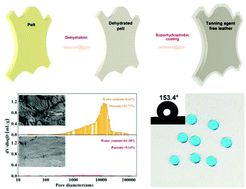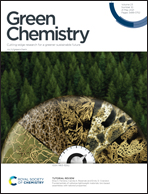Tanning agent free leather making enabled by the dispersity of collagen fibers combined with superhydrophobic coating†
Abstract
Conventionally, the manufacture of leather relies on the utilization of tanning agents that are capable of forming cross-linkages among collagen fibers, thus realizing the transformation of rawhide into leather. This theory has been followed for more than a hundred years. Herein, we realized tanning agent free leather making, which was achieved by controlled dehydration of pelt with ethanol, followed by a superhydrophobic coating. The controlled dehydration of the pelt guaranteed high dispersity of collagen fibers with substantially enhanced porosity, and the dehydrated pelt with the water content of ≤8.90% exhibited leather-like properties. The superhydrophobic coating improved the water repellency of dehydrated pelt significantly, which prevented the re-absorption of water by dehydrated pelt, thus allowing for the as-prepared leather to stably present leather-like properties. Notably, tanning agent free leather exhibited comparable physical properties to those of conventional chrome tanned leather, including the tensile strength (19.24 N mm−2), tear force (94.27 N), elongation at break (49.57%) and fullness. The tanning agent free leather making strategy developed by us might open up a new way for realizing environmentally benign leather manufacture.



 Please wait while we load your content...
Please wait while we load your content...